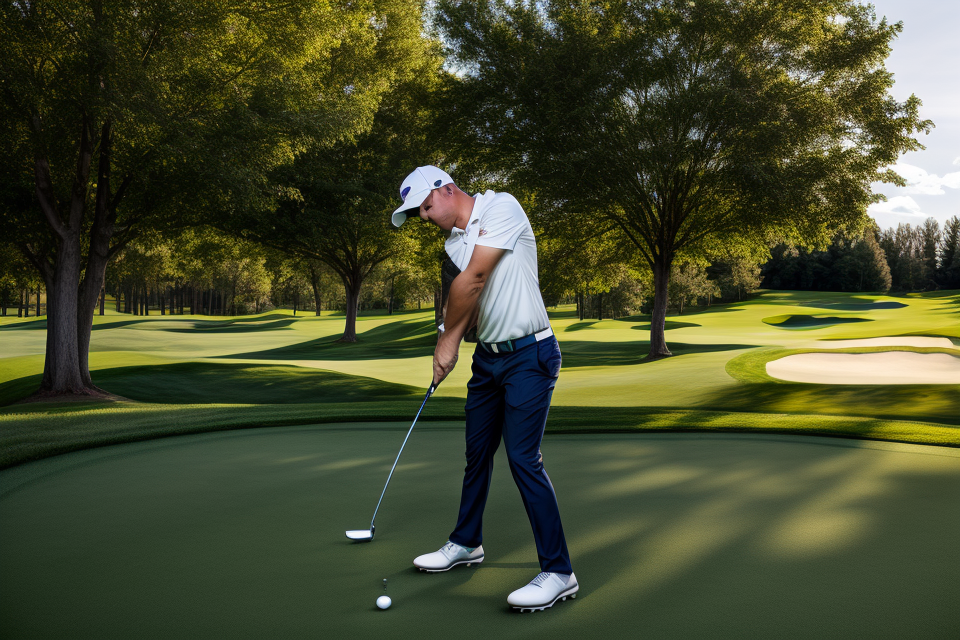
Golf is a sport that requires precision, patience, and practice. Improving your golf swing is a crucial aspect of becoming a skilled golfer. Whether you’re a beginner or an experienced player, there’s always room for improvement. In this guide, we’ll provide you with some tips and techniques to help you master the basics of your golf swing. We’ll cover topics such as grip, stance, and swing mechanics, all of which are essential to improving your game. So grab your clubs, and let’s get started on the path to a better golf swing!
Understanding the Golf Swing
The Anatomy of a Golf Swing
Grip
The grip is the first point of contact between the golfer and the club. A correct grip is essential for a good swing, as it provides stability and control throughout the swing. A typical golf grip is a neutral grip, with the hands held in a natural position, palms facing each other, and the thumbs pointing downwards.
Stance
The stance is the position of the golfer’s body during the swing. A correct stance ensures balance and stability, allowing the golfer to make a smooth and powerful swing. A proper stance involves standing with the feet shoulder-width apart, with the left side of the body facing the target, and the knees slightly bent.
Address
The address is the starting position of the swing, where the golfer stands with the club in front of them, ready to swing. A correct address position ensures that the golfer is in a balanced and stable position, with the club parallel to the ground, and the hands and body aligned towards the target.
Backswing
The backswing is the movement of the club from the address position to the top of the swing. A correct backswing involves a smooth and controlled movement of the club, rotating the shoulders and hips, and raising the club upwards towards the sky.
Downswing
The downswing is the movement of the club from the top of the swing to the impact point. A correct downswing involves a powerful and controlled movement of the club, bringing it down towards the ball in a sweeping motion.
Impact
Impact is the point where the club makes contact with the ball. A correct impact position involves the club face being square to the target, with the hands and body in a balanced and stable position.
Follow-through
The follow-through is the movement of the club after impact, continuing towards the target. A correct follow-through involves a smooth and controlled movement of the club, with the arms and body continuing to move in a straight line towards the target.
The Importance of Fundamentals
Correct Grip
A proper grip is crucial for a consistent and accurate golf swing. The grip should be firm but not tight, allowing for natural wrist movement during the swing. The dominant hand should be placed on the handle with the fingers wrapping around it, while the non-dominant hand should be placed on the handle slightly below the dominant hand.
Proper Stance
The stance is the foundation of the golf swing, and it should be balanced and stable. The feet should be shoulder-width apart, with the ball positioned slightly behind the dominant foot. The knees should be slightly bent, and the weight should be distributed evenly on both feet. The shoulders should be aligned with the hips, and the arms should be relaxed.
Alignment
Proper alignment is essential for accuracy and distance control. The feet, hips, and shoulders should be aligned parallel to the target line. The head should be positioned behind the ball, and the eyes should be focused on the target.
Posture
Good posture is critical for a powerful and efficient golf swing. The spine should be straight and aligned with the target, and the shoulders should be relaxed. The chest should be up, and the head should be in a neutral position.
Balance
Balance is crucial for a smooth and controlled golf swing. The weight should be distributed evenly on both feet, with the majority of the weight on the back foot during the backswing and on the front foot during the downswing. The hips should also be balanced, moving in sync with the upper body.
Timing
Timing is essential for a consistent and powerful golf swing. The swing should be initiated with the lower body, moving the hips and upper body in sync. The wrists should be uncocked at impact, and the club should be released naturally through the ball.
Overall, mastering the fundamentals of the golf swing is essential for any beginner looking to improve their game. By focusing on the proper grip, stance, alignment, posture, balance, and timing, golfers can develop a solid foundation for a consistent and accurate swing.
Common Mistakes to Avoid
Swing Flaws and How to Fix Them
Swing flaws are common among beginner golfers, and addressing them can greatly improve your game. Here are some of the most common swing flaws and how to fix them:
Over the top or under the bottom swing
An over the top swing, where the club moves too far away from the body, can lead to a slice. An under the bottom swing, where the club moves too close to the body, can lead to a hook. To fix these flaws, focus on keeping the club in front of the body throughout the swing.
Casting or flipping the club
Casting refers to the tendency to throw the club away from the body during the backswing. Flipping refers to the tendency to bring the club back too quickly and then swing it forward. To fix casting and flipping, focus on keeping the club in front of the body throughout the swing and maintaining a smooth, rhythmic motion.
Swaying or leaning during the swing
Swaying or leaning during the swing can throw off the balance and cause inconsistent shots. To fix swaying and leaning, focus on keeping the core stable and the body centered over the ball throughout the swing.
Rushing or slowing down the swing
Rushing the swing can lead to inconsistent contact and slicing, while slowing down the swing can lead to topping the ball or fat shots. To fix rushing and slowing down, focus on maintaining a smooth, rhythmic motion and keeping the pace of the swing consistent.
Hitting from the toes or heels
Hitting from the toes can cause the ball to fly too high and land short, while hitting from the heels can cause the ball to fly too low and land long. To fix hitting from the toes or heels, focus on keeping the body in balance and centered over the ball, and aim for a smooth, consistent contact with the ball.
Mental Game
When it comes to improving your golf swing, the mental game is just as important as the physical aspects. Here are some common mistakes beginners make when it comes to their mental game:
- Pressure and Expectations: When you’re on the golf course, it’s easy to feel pressure to perform well. Whether it’s from yourself or others, this pressure can cause you to tense up and lose focus. It’s important to remember that golf is a game, and the most important thing is to have fun. Don’t put too much pressure on yourself to perform well, and try to enjoy the experience of being on the course.
- Lack of Focus and Concentration: In order to improve your golf swing, you need to be fully present and focused on the task at hand. This means avoiding distractions, such as thinking about work or personal issues, and staying focused on the shot at hand. One way to improve your focus is to use visualization techniques, such as imagining the perfect shot in your mind before taking it.
- Negative Self-Talk: It’s easy to get frustrated when you’re not hitting the ball as well as you’d like. However, it’s important to avoid negative self-talk, such as telling yourself that you’re a terrible golfer or that you’ll never improve. Instead, focus on positive self-talk, such as reminding yourself of your strengths and what you’ve accomplished so far. Remember that improvement is a gradual process, and it’s important to be patient with yourself.
Building a Solid Swing
Warm-up and Stretching
As a beginner golfer, it’s important to understand the importance of warming up and stretching before hitting the course. Warming up and stretching can help prevent injury, improve flexibility, and increase the effectiveness of your swing. Here are some specific techniques you can use to warm up and stretch before hitting the links:
Light Practice Swings
Before you start your round, take a few minutes to do some light practice swings. This will help you get a feel for your swing and loosen up your muscles. Start with some slow, controlled swings, then gradually increase your speed as you become more comfortable.
Dynamic Stretching
Dynamic stretching involves moving your joints through their full range of motion, which can help improve flexibility and reduce the risk of injury. Here are some dynamic stretches you can try before your round:
- Arm circles: Stand with your feet shoulder-width apart and swing your arms in circles, first forward then backward.
- Leg swings: Stand with your feet hip-width apart and swing one leg forward and backward, then switch legs.
- Torso twists: Stand with your feet shoulder-width apart and twist your torso from side to side.
Balance Exercises
Good balance is essential for a good golf swing, so it’s important to do exercises that focus on improving your balance. Here are some balance exercises you can try before your round:
- Single-leg squats: Stand on one leg and lower your body into a squat, then rise back up.
- Heel-to-toe walks: Walk heel-to-toe along a straight line, balancing on the balls of your feet.
- Single-leg deadlifts: Stand on one leg and lift the other leg off the ground, then lower it back down.
Remember, warming up and stretching should be a regular part of your pre-round routine. By taking a few minutes to loosen up your muscles and improve your flexibility, you’ll be in a better position to hit the ball further and straighter.
Practice Drills
- Short game practice
- Focus on chipping and pitching to improve accuracy and control around the green.
- Practice different types of shots, such as bunker shots and chip shots from various lies.
- Pay attention to the distance control and the trajectory of the ball.
- Chipping and pitching
- Work on your chipping and pitching technique to improve your accuracy and control around the green.
- Putting
- Focus on your putting technique to improve your accuracy and speed on the greens.
- Practice different types of putts, such as straight putts and breaking putts.
- Pay attention to your stroke technique, including your grip, stance, and body movements.
- Full swing practice
- Work on your full swing technique to improve your distance and accuracy off the tee and on approach shots.
- Practice your backswing and downswing, focusing on a smooth transition between the two.
- Pay attention to your ball position and body alignment at address.
Incorporating Feedback
Feedback is an essential component of improving your golf swing. By seeking out and incorporating feedback, you can identify areas for improvement and make necessary adjustments to your technique. Here are some ways to incorporate feedback into your golf swing:
- Video Analysis: Using video analysis is a great way to gain insight into your swing. You can record your swing using a smartphone or a golf simulator, and then review the footage with a coach or on your own. By watching your swing in slow motion, you can identify any technical flaws or inconsistencies in your form.
- On-Course Feedback: Playing golf with other people can provide valuable feedback on your swing. If you’re playing with a partner or a group, ask them to observe your swing and provide feedback on areas where you could improve. Alternatively, you can ask a golf pro to observe your swing on the course and provide feedback.
- Seeking Professional Advice: If you’re serious about improving your golf swing, seeking professional advice is essential. A golf pro can provide personalized feedback on your swing, identify any technical flaws, and provide guidance on how to make adjustments. They can also provide personalized exercises and drills to help you improve your swing.
Overall, incorporating feedback is an important step in mastering the basics of your golf swing. By seeking out feedback from a variety of sources, you can gain a better understanding of your swing and make the necessary adjustments to improve your technique.
Review and Reflection
As you continue to practice and refine your golf swing, it’s important to periodically review and reflect on your progress. This not only helps you identify areas that need improvement, but also gives you a sense of accomplishment and motivation to continue working towards your goals. Here are some key points to consider when reviewing and reflecting on your golf swing:
- Recap of key points: Take some time to review the key points you’ve learned so far. This might include things like the correct grip, stance, and swing sequence, as well as the importance of using your core muscles and keeping your head still during the swing. Make sure you understand each point and can apply it to your swing.
- Personal assessment of progress: Be honest with yourself about your progress. Identify areas where you’ve made significant improvements, as well as areas where you still struggle. Consider seeking feedback from a golf instructor or more experienced golfer to get an outside perspective on your swing.
- Setting future goals: Once you’ve assessed your progress, set new goals for yourself. These might include improving your distance, accuracy, or consistency, or working on specific aspects of your swing, such as reducing your slice or pulling your shots. Make sure your goals are specific, measurable, and achievable.
- Staying motivated and committed: Golf can be a frustrating sport, and it’s easy to get discouraged when you’re not seeing the results you want. However, it’s important to stay motivated and committed to your goals. Find ways to keep yourself motivated, whether it’s by tracking your progress, playing with friends, or rewarding yourself for small victories. Remember that improvement takes time and practice, and that every successful shot is a step in the right direction.
FAQs
1. What are the basic elements of a good golf swing?
A good golf swing consists of several basic elements that work together to produce a powerful and accurate shot. These elements include grip, stance, posture, swing plane, and follow-through. A proper grip ensures that the club is held correctly, while the stance and posture help to maintain balance and control throughout the swing. The swing plane refers to the path that the club travels along during the swing, and the follow-through ensures that the club is square to the target line at impact.
2. How should I position my hands on the golf club?
To position your hands correctly on the golf club, you should hold the club with your dominant hand at the bottom of the grip and your non-dominant hand above it. Your dominant hand should be responsible for controlling the clubface during the swing, while your non-dominant hand should provide support and stability. Your palms should be facing each other, with your thumbs aligned along the shaft of the club.
3. What is the correct golf swing sequence for beginners?
The correct golf swing sequence for beginners involves a series of steps that ensure a smooth and efficient swing. These steps include setting up to the ball, taking the club back, turning your body and hips, and finishing the swing with a follow-through. It’s important to keep your head down and your eyes focused on the ball throughout the swing, and to avoid swinging too fast or too slow.
4. How can I improve my swing speed?
To improve your swing speed, you need to focus on developing your muscle strength and control. You can do this by practicing your swings with lighter clubs or by using swing aids such as resistance bands or weighted clubs. It’s also important to maintain a smooth and controlled rhythm throughout the swing, rather than trying to swing too fast or too hard. Finally, be sure to practice your swing regularly to build muscle memory and improve your speed over time.
5. What are some common mistakes that beginners make when swinging a golf club?
Common mistakes that beginners make when swinging a golf club include gripping the club too tightly, taking an incorrect stance, and swinging too fast or too slow. Other mistakes include losing your balance during the swing, failing to maintain a proper body position, and not following through properly after impact. By focusing on the basics of the swing and practicing regularly, you can avoid these common mistakes and develop a more consistent and effective swing.


